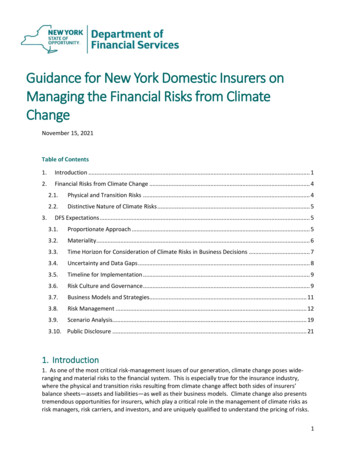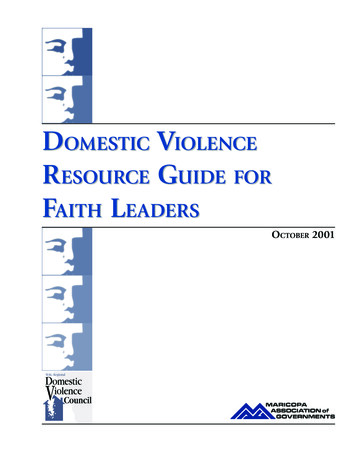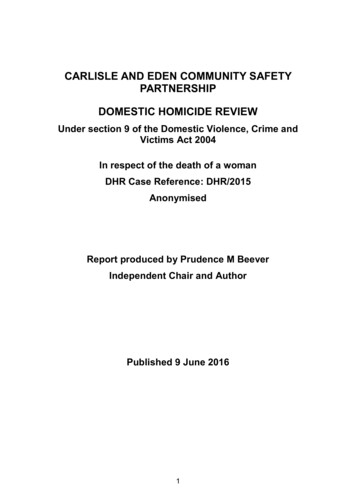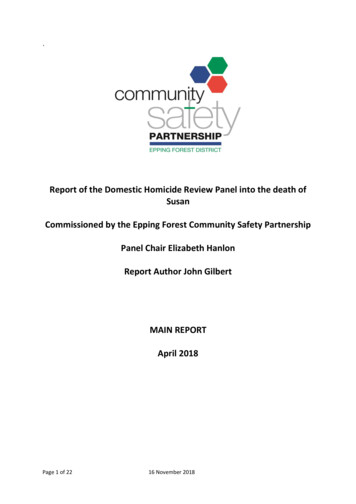
Transcription
Guidance for New York Domestic Insurers onManaging the Financial Risks from ClimateChangeNovember 15, 2021Table of Contents1.Introduction . 12.Financial Risks from Climate Change . 43.2.1.Physical and Transition Risks . 42.2.Distinctive Nature of Climate Risks . 5DFS Expectations . 53.1.Proportionate Approach . 53.2.Materiality. 63.3.Time Horizon for Consideration of Climate Risks in Business Decisions . 73.4.Uncertainty and Data Gaps . 83.5.Timeline for Implementation . 93.6.Risk Culture and Governance . 93.7.Business Models and Strategies. 113.8.Risk Management . 123.9.Scenario Analysis. 193.10. Public Disclosure . 211. Introduction1. As one of the most critical risk-management issues of our generation, climate change poses wideranging and material risks to the financial system. This is especially true for the insurance industry,where the physical and transition risks resulting from climate change affect both sides of insurers’balance sheets—assets and liabilities—as well as their business models. Climate change also presentstremendous opportunities for insurers, which play a critical role in the management of climate risks asrisk managers, risk carriers, and investors, and are uniquely qualified to understand the pricing of risks.1
These opportunities include helping communities be more resilient through inclusive and affordableinsurance, contributing to climate change adaptation and mitigation, and enhancing the insurability ofclimate-related risks. To continue to thrive in the face of global competition, it is essential that NewYork insurers both manage the financial risks and take advantage of the opportunities arising fromclimate change.2. The Sixth Assessment Report of the Intergovernmental Panel on Climate Change (“IPCC”) states that“[t]he scale of recent changes across the climate system as a whole and the present state of manyaspects of the climate system are unprecedented over many centuries to many thousands of years.”1Climate-related risks present unique challenges and require a strategic response by the insuranceindustry, including the acquisition of new knowledge, expertise, and tools. At the same time, generalprinciples and approaches of good governance and risk management laid out in the New York InsuranceLaw and related regulations, and the guidance manuals of the National Association of InsuranceCommissioners (“NAIC”), apply to climate risks in the same way as other risks that may be more familiarto insurers.3. To support New York domestic insurers (“insurers”) in managing the financial risks from climatechange (“climate risks”), the New York State Department of Financial Services (“DFS”) solicitedcomments on a proposed version of this guidance on March 25, 2021. DFS received detailed commentsfrom 45 parties, including industry trade groups, insurance companies, consumer advocates, climateexperts, rating agencies, financial regulators, and individual citizens. This final guidance reflects DFS’scareful consideration of all comments received.4. This guidance is informed by DFS’s ongoing dialogue with the insurance industry over the past year,analysis of the potential climate risk exposure of insurers’ assets, and collaboration with internationaland other U.S. regulatory bodies. This guidance also reflects DFS’s review of insurers’ enterprise riskreports, Own Risk and Solvency Assessment (“ORSA”) summary reports, NAIC Climate Risk DisclosureSurvey responses, and other voluntarily filed disclosure materials, including Task Force on Climaterelated Financial Disclosures (“TCFD”) reports, sustainability reports, and disclosure questionnaires.Based on this review, there is a wide range of levels of maturity and sophistication among insurers interms of understanding and managing climate risks, with larger insurers typically more advanced thansmaller ones, which in some cases have not yet considered climate risks.5. This guidance builds on relevant provisions of the New York Insurance Law, NAIC Financial ConditionExaminers Handbook 2020 (“Handbook”), and NAIC ORSA Guidance Manual as of December 2017(“ORSA Manual”). It is also modeled on publications, guidance, and supervisory statements issued byinternational regulators and networks, such as the Bank of England Prudential Regulation Authority(“PRA”), the International Association of Insurance Supervisors (“IAIS”), the Sustainable Insurance Forum(“SIF”), the European Insurance and Occupational Pensions Authority (“EIOPA”), the European CentralBank (“ECB”), the Network for Greening the Financial System (“NGFS”), and the Dutch Central Bank. DFSis profoundly grateful for their work.6. At a high level, international regulators’ expectations on managing climate risks are consistent,including similar components, a focus on proportionality and long-term analysis, and the expectation ofan increasing level of sophistication over time. To ensure consistency across jurisdictions, internationalregulators have engaged in meaningful collaboration and coordination to develop international best1IPCC, Sixth Assessment Report – Headline Statements from the Summary for Policymakers, August 9, 2021.2
practices. DFS intends to continue to work closely with international and other U.S. regulators to reducethe compliance burden on insurers.7. Although no one is spared from the impact of climate change, it disproportionately affectsdisadvantaged communities, including low-income communities and communities of color, and feedsinto the vicious circle of social inequality. DFS is committed to supporting fair, safe, and stable insurancemarkets for the benefit and protection of all New Yorkers. While this guidance is focused on thefinancial stability of insurers in the face of climate change, it is also crucial for insurers to do their part tocontribute to the low-carbon transition and climate adaptation efforts; support communities’ resilienceto climate change, especially in disadvantaged communities that would be even more vulnerable toclimate change if insurers stop insuring or investing in these communities; and work with the publicsector to find ways to close the protection gap and ensure that insurance is available and affordablethroughout the State.8. DFS expects this guidance to serve as a basis for supervisory dialogue and to help insurers familiarizethemselves with climate risks and develop their capacity and processes for managing them inaccordance with the timelines specified in the guidance. DFS intends to monitor insurers’ progress inimplementing the expectations in this guidance.29. DFS will continue to develop its supervisory approach to managing and disclosing climate risks,considering U.S. federal and state regulatory developments as well as evolving practices in the industryand in the national and international supervisory community. Over time, DFS expects its approach toshift from supporting insurers’ progress in implementing DFS’s supervisory expectations in accordancewith the timelines specified in this guidance, to active supervision against those expectations.Overview of DFS Supervisory Expectations10. As explained in more detail below, DFS expects insurers to take a strategic approach to managingclimate risks that considers both current and forward-looking risks and identifies actions required tomanage those risks in a manner proportionate to the nature, scale, and complexity of insurers’businesses. Specifically, an insurer should:I.Integrate the consideration of climate risks into its governance structure at the group or insurerentity level. The insurer’s board should understand climate risks and maintain oversight overthe management team responsible for managing them. The roles of the board andmanagement should be reflected in the company’s risk appetite and organizational structure.II.When making business decisions, consider the current and forward-looking impact of climaterelated factors on its business using time horizons that are appropriately tailored to the insurer,its activities, and the decisions being made.III.Incorporate climate risks into the insurer’s existing financial risk management, including byembedding climate risks in its risk management framework and analyzing the impact of climaterisks on existing risk factors. Climate risks should be considered in the company’s ORSA.2To assist insurers that are in the early stages of this work, examples are provided to illustrate the expectations inthis guidance, which should not be viewed as mandatory.3
IV.V.Use scenario analysis to inform business strategies and risk assessment and identification.Scenarios should consider physical and transition risks, multiple carbon emissions andtemperature pathways, and short-, medium-, and long-term horizons.Disclose its climate risks and engage with the TCFD and other initiatives when developing itsdisclosure approaches.2. Financial Risks from Climate Change2.1. Physical and Transition Risks11. Physical risks arise from the increasing frequency, severity, and volatility of acute events, such ashurricanes, floods, and wildfires. They also stem from chronic shifts in weather patterns, such as risingsea levels resulting in more flooding and coastal erosion, droughts disrupting agriculture production,and intensifying heat waves which are responsible for more annual deaths than any other weatherrelated hazards.3 Climate change has increased heat and precipitation extremes across the globe, aswell as the likelihood of multiple perils occurring at once (e.g., concurrent heat waves and droughts,flooding caused by storm surge and extreme rainfall).4 These risks directly affect property/casualtyinsurers’ liabilities and the long-term viability of certain business lines. As the effects of climate changecontinue to unfold, physical risks will likely become more complex and harder to model, furtherchallenging insurers’ attempts to manage those risks. Climate-related natural disasters can also causebusiness disruption, destruction of capital, increased costs to recover from disasters, stress oninfrastructure, reduced revenue, and migration. In turn, these can lead to lower residential andcommercial property values, lower household wealth, lower corporate profitability, and stress on socialand economic systems, translating into financial and credit market losses that affect insurers’ assets.12. Transition risks arise from society’s transition towards a low-carbon economy, driven by policy andregulations (such as the potential introduction of a carbon tax or carbon allowances), low-carbontechnology advancement, and shifting sentiment and societal preferences. This transition can lead tostranded assets in the fossil-fuel industry and carbon-intensive infrastructure, real estate, andvehicles. It can also result in costs to reinvest in and replace infrastructure, and increased litigationagainst fossil-fuel companies. Transition risks can lead to corporate asset devaluation, lower corporateprofitability, lower property values, and lower household wealth. In turn, related financial and creditmarket losses will affect insurers’ assets, while increased litigation will impact insurers’ liabilities and thelong-term viability of certain business lines. Sectors with high transition risks include coal mining, oil andgas (including drilling, pipelines, refineries, and services), utilities, transportation, chemicals, truckingand leasing, auto manufacturing, cement, and mining.13. Physical and transition risks can give rise to climate-related claims under liability policies, such asdirectors’ and officers’ liability insurance policies,5 as well as direct actions against insurers for failing to3Extreme Heat, Ready.Gov, accessed on October 19, 2021.IPCC, Sixth Assessment Report – Headline Statements from the Summary for Policymakers, August 9, 2021. IPCC,The concept of risk in the IPCC Sixth Assessment Report: a summary of cross-Working Group discussions –Guidance for IPCC authors, September 4, 2020.5PRA, Supervisory Statement, SS3/19, Enhancing banks’ and insurers’ approaches to managing the financial risksfrom climate change, April 2019.44
manage climate risks.6 These liability risks are not identified in this guidance as a separate risk factor,but rather are part of the discussion of physical and transition risks.2.2. Distinctive Nature of Climate Risks14. Climate risks present unique challenges and require a strategic approach to financial riskmanagement. Climate risks are:7a. Far-reaching in breadth and magnitude: Not only does climate change affect all aspects of oureconomy globally, but its impact may also be non-linear, correlated, and irreversible.b. Uncertain but foreseeable: Climate-driven change is inevitable, even though its exactmanifestations and timing are uncertain. The concentration of greenhouse gases in theatmosphere will continue to increase in the short term, leading to more extreme and chronicweather events. Over time, certain physical risks could become uninsurable if the low-carbontransition happens too slowly or too late. Some insurers are already limiting coverage, or exitingthe market entirely, in regions that experience frequent climate-related natural disasters.Governments and society more broadly are responding by ramping up efforts to mitigateclimate change. The low-carbon transition could be orderly, with minimum negative impact onthe economy, or disorderly, which would disrupt the economy and financial markets. Ifsignificant action is taken but too late to achieve the Paris Agreement goal of limiting globalwarming to well below 2 degrees Celsius above pre-industrial levels, the resulting financialdisruption could be severe.c. Dependent on short-term actions: The ultimate impact of climate change depends in large parton the nature and extent of the actions taken in the near term by governments, corporations,and individuals and communities around the world to fight climate change.d. Hard to predict based on past experience: Certain physical and transition risks are unlikely to beadequately captured in historical data given their unprecedented and long-term nature. Giventhe forward-looking nature of climate risks and the inherent uncertainty of both the physicalimpact of climate change and resulting societal responses, past experience will not necessarilybe a good indicator of future conditions.3. DFS Expectations3.1. Proportionate Approach15. DFS expects each insurer to take a proportionate approach to managing climate risks that reflects itsexposure to climate risks and the nature, scale, and complexity of its business. Climate change affectseach insurer in different ways and to different degrees depending on the insurer’s size, complexity,geographic distribution, business lines, investment strategies, and other factors. Not all insurers havethe same level of resources to devote to managing climate risks and some insurers will take longer thanothers to develop and implement appropriate practices. However, all insurers, regardless of size, areexpected to analyze their climate risks on both the underwriting and investment sides of their balancesheets. Small insurers are not necessarily less exposed to climate risks because they may have6IAIS and SIF, Application Paper on the Supervision of Climate-related Risks in the Insurance Sector, May 2021.PRA, Supervisory Statement, SS3/19, Enhancing banks’ and insurers’ approaches to managing the financial risksfrom climate change, April 2019.75
concentrated business lines or geographies that are highly exposed to climate risks without the benefitof diversification available to larger insurers.16. As an insurer’s expertise and understanding of climate risks develop, DFS expects the insurer’sapproach to managing these risks to mature. Over time, an insurer’s analysis of climate risks andassessment of their materiality for its business should shift from a qualitative approach to an approachthat is both qualitative and quantitative for risks that can be quantified.8 While a qualitative assessmentmay be based on simple models and a small set of risk factors, a quantitative assessment should seek toquantify those risks based on increasingly sophisticated tools like geospatial data and climate modeling,and a broader set of relevant risk factors, including those described in the Handbook (i.e., credit, legal,liquidity, market, operational, pricing and underwriting, reputational, and strategic risks).17. An insurer that is developing a climate risk approach or model may need more time to incorporate itinto its risk management function, or to establish an adequate control environment. The insurer shouldstart by qualitatively analyzing the impact of climate risks on the risk factors described in the Handbookfor its business lines and assets. In addition, it should assess how its business (both assets and liabilities)may perform under various scenarios and time frames. Scenarios could include: (1) an orderlytransition that phases out fossil fuel-based energy and transportation with minimum financial marketdisruption and a limited increase in natural disasters; (2) a disorderly transition with a large financialmarket disruption and a limited increase in natural disasters; (3) a disorderly transition with a drasticincrease in natural disasters; and (4) no transition (as the economy continues to use the same amount offossil fuel) with a drastic increase in natural disasters.18. An insurer that is part of a group can utilize policies, procedures, and processes developed at thegroup level for managing climate risks if: (1) the risks considered at the group level include those facingthe insurer; (2) the policies, procedures, and processes developed at the group level are implemented atthe level of the insurer and address the insurer’s material climate risks; and (3) the insurer hasappropriate access to relevant climate-related resources and expertise centralized at the group level. Ifthese conditions are met, references in this guidance to an insurer’s board can also mean the board ofthe group of which the insurer is a part. If an insurer’s policies, procedures, or processes differmeaningfully from those of the group, the insurer should document and provide a justification for thosedifferences in its risk management reports.3.2. Materiality19. This guidance, which includes several references to materiality or to material risks or exposure, isintended to address material climate risks faced by insurers. The quantification of climate risks is still adeveloping area with uncertain or, in some cases, unavailable data and models. However, this does notpreclude insurers from making informed judgments about the significance of climate risks to theirbusinesses. For insurers early in the process of managing climate risks or with limited resources, amateriality assessment may be based on qualitative information, and on an analysis of portfolioexposure to certain sectors or geographies in underwriting or investments. Over time, when qualitativeanalyses demonstrate the probability of material climate risks, this assessment should include8Examples of quantitative metrics can be seen in Section 3.8.1.2 (“Risk Appetite, Tolerances, and Limits”).6
quantitative analyses and rely on methods such as scenario analysis and stress testing that includerelevant sectors and geographies.20. The Handbook provides guidance for determining materiality in the examination context.9 Whenassessing the materiality of climate risks, insurers may use the Handbook’s materiality benchmarks (e.g.,5% of surplus or one-half of 1% of total assets), subject to adjustment based on professional judgmentand circumstances. A risk may also be considered material where knowledge of the risk could influencethe decisions or judgment of an insurer’s board, management, regulators, or other relevantstakeholders.10 These types of risks could include exposure to natural disasters that are stronglyinfluenced by climate change for property/casualty insurers, and investment exposure to geographiesand sectors that have high transition or physical risks for life insurers.21. Insurers should regularly assess their materiality assumptions.11 Depending on the nature, scale,and complexity of its business, an insurer should conduct this assessment at least annually, and in theevent of a significant change, such as a material regulatory development or material change to itsinternal climate modeling.3.3. Time Horizon for Consideration of Climate Risks in Business Decisions22. A strategic response to climate change requires a longer-term view than the typical businessplanning horizon of three to five years. The time horizon for analyzing financial risks and opportunitiesrelated to climate change should gradually go beyond the standard three to five years to a medium-term(e.g., five to ten years) and ultimately long-term (e.g., ten to 30 years) view. DFS’s expectation for thetiming of this progression will depend on the situation of each insurer, with insurers with the mostdeveloped climate-related risk profiles or the most material climate risks expected to startexperimenting with the long-term horizon now and other insurers in the next two to three years.23. When making a specific business decision, each insurer should consider climate risks based on atime horizon that is tailored to its business and activities and the nature of that decision. For example, aproperty/casualty insurer’s consideration of climate risks in underwriting and pricing policies, ordetermining an appropriate risk transfer strategy, may be based on a relatively short time horizon (oneto five years).12 By contrast, given the long-dated nature of life insurers’ liabilities, the impact of climatechange on their investment portfolios may materialize over an extended period of time and thereforeimpact either the value of or expected cash flows from their financial assets only in the long-term.However, as transition risks can materialize suddenly, all insurers should think about how climate risksand opportunities might affect their investment strategies now.139Handbook, SECTION 1 – GENERAL EXAMINATION GUIDANCE, III. General Examination Consideration, B.MATERIALITY, Pages 61-63.10EIOPA, Opinion on the supervision of the use of climate change risk scenarios in ORSA, April 19, 2021.11One example of a tool that insurers can use for the assessment is the mapping of climate risks to existing riskfactors as shown in Annexes 3 and 4 of EIOPA’s Opinion on the supervision of the use of climate change riskscenarios in ORSA, April 19, 2021.12PRA, A framework for assessing financial impacts of physical climate change – A practitioner’s aide for thegeneral insurance sector, May 2019.13IAIS and SIF, Application Paper on the Supervision of Climate-related Risks in the Insurance Sector, May 2021.7
24. When developing a new product, assessing a possible merger or acquisition, or determining the sizeor composition of their product portfolios for a region or business line, insurers may need to considerclimate risks over the medium term (five to ten years). By contrast, other decisions, such as thoserelating to risk management, risk appetite setting, or financial reporting, may require a medium to aneven longer (more than ten years) time horizon. Climate risks may not materialize within the traditionaltime horizon of insurers’ risk appetite statements, which tends to be one to five years. Insurers shouldtherefore formulate risk appetite statements that consider climate risks over a longer period.1425. Similarly, when developing a public policy engagement strategy or preparing TCFD-aligneddisclosures, a long-term view is necessary to consider potential adaptation measures that may mitigateissues of future insurability or affordability. For example, a 30-year time horizon, with interim sciencebased targets and milestones, may be appropriate for net zero investment or underwritingcommitments made by some insurers.15 Decisions may be recalibrated over time as additionalinformation becomes available or models and strategies change.3.4. Uncertainty and Data Gaps26. Many aspects of climate change, and governments’ and society’s evolving response to climatechange, are still uncertain or unknown, but uncertainty and data gaps do not justify inaction.27. To address the unique challenges posed by climate change, insurers must adapt their traditionaltools for identifying, monitoring, and managing risks. Even when short-term average outcomes like theaverage loss from a natural peril over a year have not shifted significantly, climate change has increasedthe likelihood of extreme events.16 Prudent risk management requires that insurers look at the fullrange of potential future outcomes and consider forward-looking data. The risk to insurers is inunderestimating extreme weather events or not fully capturing the connections between physical andtransition risks that lead to higher losses from these events.28. There has been significant advancement in areas like climate science, methodology, and disclosureas evidenced by the Sixth Assessment Report of the IPCC, the NGFS climate scenarios, and the increasingadoption of TCFD. Technology exists today – provided by rating agencies, asset managers, and specialtyservice providers – to quantitatively assess the resilience of investment portfolios to transition andphysical risks under a range of scenarios.29. Many expectations in this guidance are not affected by uncertainty or data gaps and can beimplemented with relative speed and confidence. For example, insurers should establish boardgovernance and an organizational structure that supports the effective management of climate risks anddevelop their expertise and capacity to assess and manage climate risks on both sides of their balancesheets. By contrast, the implementation of other expectations, such as setting risk tolerance and limits,may require a more iterative approach, with insurers updating or refining their decisions as new14Bank of England Climate Financial Risk Forum, Climate Financial Risk Forum Guide 2020 – Risk ManagementChapter, June 2020.15UN-convened Net Zero Asset Owner Alliance Member List, Net Zero Insurance Alliance Members.16For example, climate change has increased both the mean and variance of temperature, resulting in much morerecord hot temperature. IPCC, Climate Change 2001 – Synthesis Report, 2001.8
information is obtained. Climate scenario analysis should be exploratory, focus on understandingpotentially material climate risks, and avoid creating a false sense of security and precision in the results.30. Insurers should also consider whether and how their model vendors and third-party investmentmanagers manage uncertainty and data gaps. Insurers that rely on vendor models for underwriting orthird-party managers for investments are still the ultimate owners of the risks and are encouraged toengage with their vendors and third-party managers to understand their assumptions and limitations,consider the potentially large uncertainty in those assumptions, and design business models andmitigation strategies (such as re-evaluation of risk appetite for certain perils, reinsurance retention andlimits, or focus on customer engagement) accordingly.31. Insurers can proactively contribute to reducing uncertainty and filling data gaps by collecting datafrom their customers, requesting or requiring climate disclosure from the companies in which theyinvest, and collaborating with peers, academics, and regulators on the subject of climate risks.3.5. Timeline for Implementation32. Implementing the expectations in this guidance involves varying levels of difficulty. DFS expectsinsurers to implement its expectations relating to board governance (Section 3.6.1), and to have specificplans in place to implement the expectations relating to organizational structure (Section 3.6.3), byAugust 15, 2022. More complex expectations, such as those relating to risk appetite, analysis of theimpact of climate risks on existing risk factors, reflection of climate risks in the ORSA, scenario analysis,and public disclosure, may take longer to implement. DFS will issue further guidance on the timing forimplementation of these more complex expectations and encourages insurers to start working on themnow.3.6. Risk Culture and Governance3.6.1. Board Governance33. An insurer’s board
and leasing, auto manufacturing, cement, and mining. 13. Physical and transition risks can give rise to climate-related claims under liability policies, such as directors' and officers' liability insurance policies,5 as well as direct actions against insurers for failing to 3 Extreme Heat, Ready.Gov, accessed on October 19, 2021.











